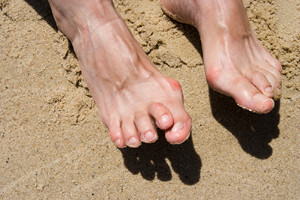

Hammertoes are a deformity where the toe bends at the middle joint, causing the tip to curl downward, resembling a hammer. This condition can affect any of the smaller toes and is categorized into flexible hammertoes, which are still movable at the joint. Rigid hammertoes are defined as tight tendons causing the joint to become misaligned and immobile. Hammertoes develop over time, often due to wearing ill-fitting shoes that squeeze the toes or cause them to bend. High heels or narrow shoes are common culprits. Genetics, certain diseases like arthritis, and trauma can also contribute to their formation. People with unusually long toes, flat feet, or high arches are more susceptible. Diagnosis typically involves a physical examination, and in some cases, X-rays to assess the extent of the deformity. Treatment options range from changes in footwear and custom orthotic devices to surgery in severe cases. If you have a hammertoe that is causing you discomfort, it is suggested that you visit a podiatrist for an accurate diagnosis and treatment options.
Hammertoe
Hammertoes can be a painful condition to live with. For more information, contact Dr. Alan J. Spector from Shore Podiatry. Our doctor will answer any of your foot- and ankle-related questions.
Hammertoe is a foot deformity that affects the joints of the second, third, fourth, or fifth toes of your feet. It is a painful foot condition in which these toes curl and arch up, which can often lead to pain when wearing footwear.
Symptoms
Causes
Genetics – People who are genetically predisposed to hammertoe are often more susceptible
Arthritis – Because arthritis affects the joints in your toes, further deformities stemming from arthritis can occur
Trauma – Direct trauma to the toes could potentially lead to hammertoe
Ill-fitting shoes – Undue pressure on the front of the toes from ill-fitting shoes can potentially lead to the development of hammertoe
Treatment
Orthotics – Custom made inserts can be used to help relieve pressure placed on the toes and therefore relieve some of the pain associated with it
Medications – Oral medications such as anti-inflammatories or NSAIDs could be used to treat the pain and inflammation hammertoes causes. Injections of corticosteroids are also sometimes used
Surgery – In more severe cases where the hammertoes have become more rigid, foot surgery is a potential option
If you have any questions please contact our office located in Point Pleasant, NJ . We offer the newest diagnostic and treatment technologies for all your foot and ankle needs.